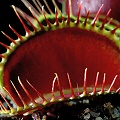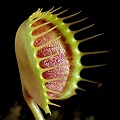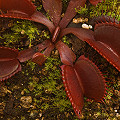Q: Dionaea: various types
A: There is only one species in the genus: Dionaea muscipula Soland. ex Ellis.
However, that has not stopped horticulturists
for making lots of interesting horticultural selections. Looking through a Dionaea specialist's
growlist can be overwhelming!
Most Dionaea plants
that have been given bona fide cultivar names can be grouped into plants with interesting attributes in
the following categories. But...let's face it...of the zillions of Dionaea cultivars, hardly
any REALLY should have been named. The plants are beautiful or interesting, sure, but do they really need a special name, especially if
the plants are barely in more than one or two collections? In any event, I suppose they are interesting
to study, since they show what Dionaea enthusiasts value most.
Trap color
Usually this involves plants that have intensely red traps, or leaf bases, or petioles. The first
Dionaea cultivar ever established was
Dionaea 'Red Dragon', an icon of this group. In my experience, Dionaea
in the wild only very rarely have red petioles. I have only seen such plants in one area in the wild, in an area I do not
care to disclose.
Unfortunately, we seem to be beset by a plague of red Dionaea cultivars which all pretty much look like
each other, except in their originator's eyes.
I have described my own cultivar with a notably green trap
(Dionaea 'Justina Davis').
Mutated traps
This includes the many plants with strangely shaped traps. Most have only minor
oddities such as short or modified marginal spines that may be triangular or sawtooth-like. However, some have
such extremely mutated traps that they can no
longer function properly (such as Dionaea 'Wacky Traps', 'Cupped Trap', and 'Fused Tooth'),
Large (or small) traps
As you might expect, plants with large traps are highly valued, such as Dionaea 'B52,'
which is a cultivar I selected for publication in one of my books.
More information can be found here:
Why isn't my Venus flytrap red like in the photos?
How many kinds of Venus flytraps are there?
Page citations: Rice, B.A. 2006a.


